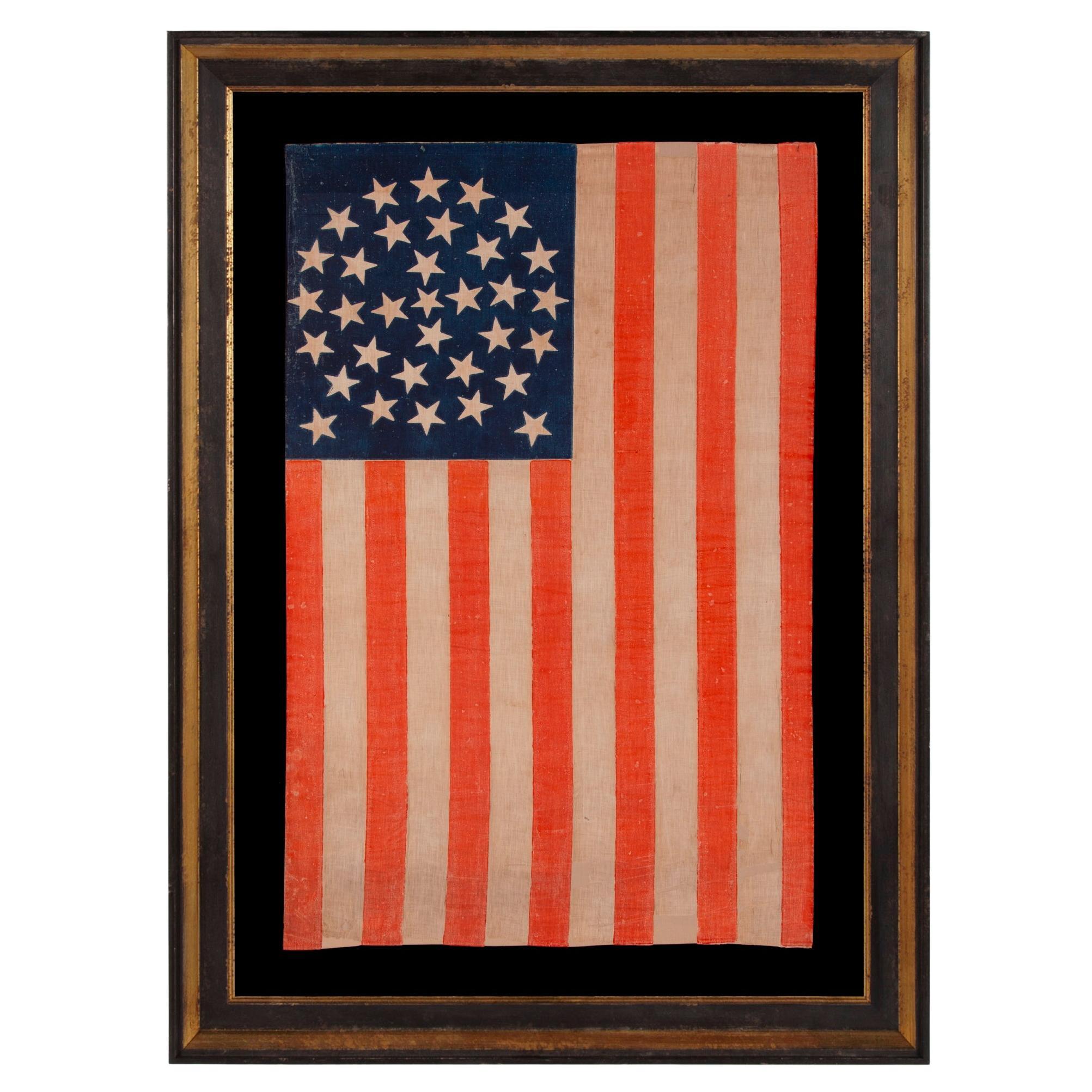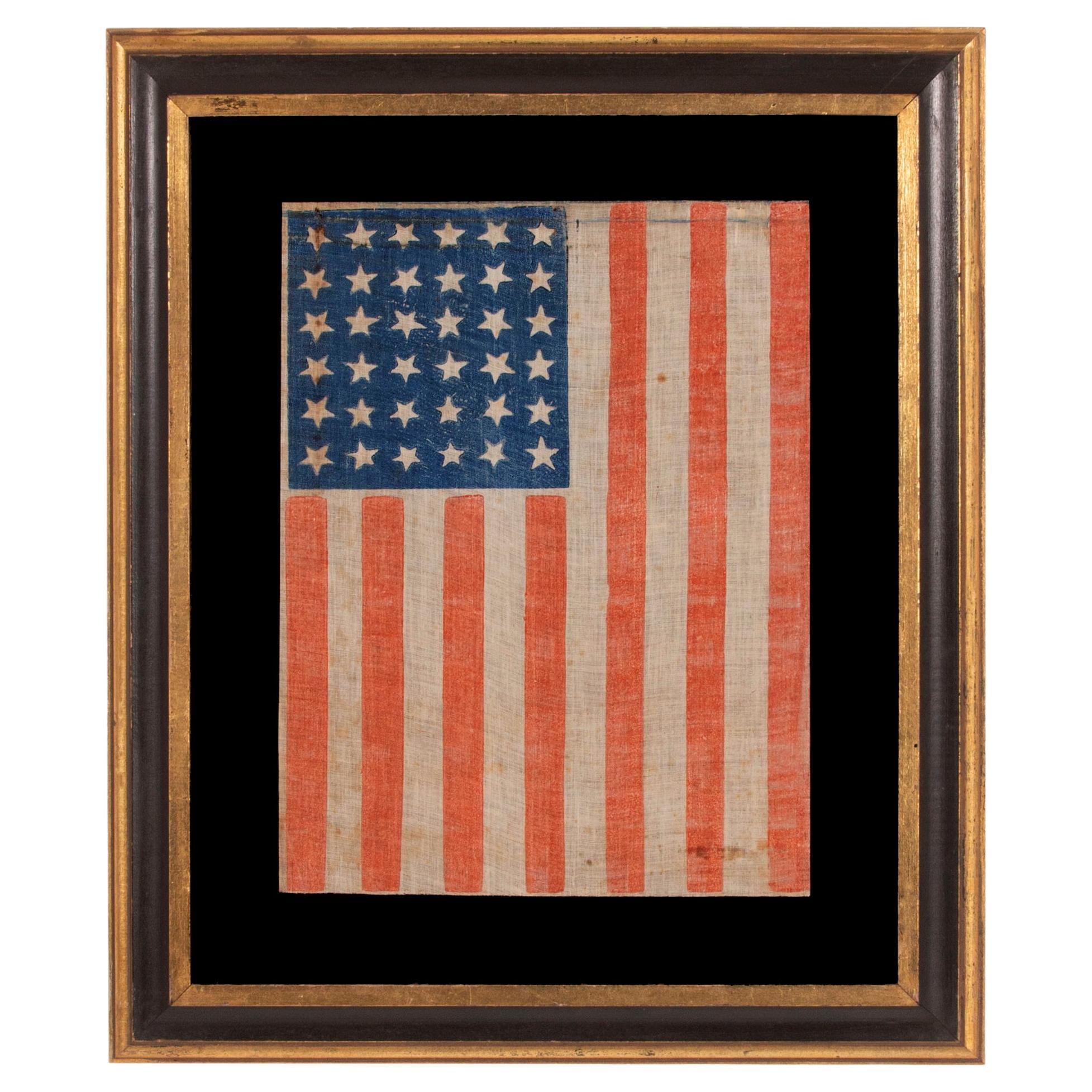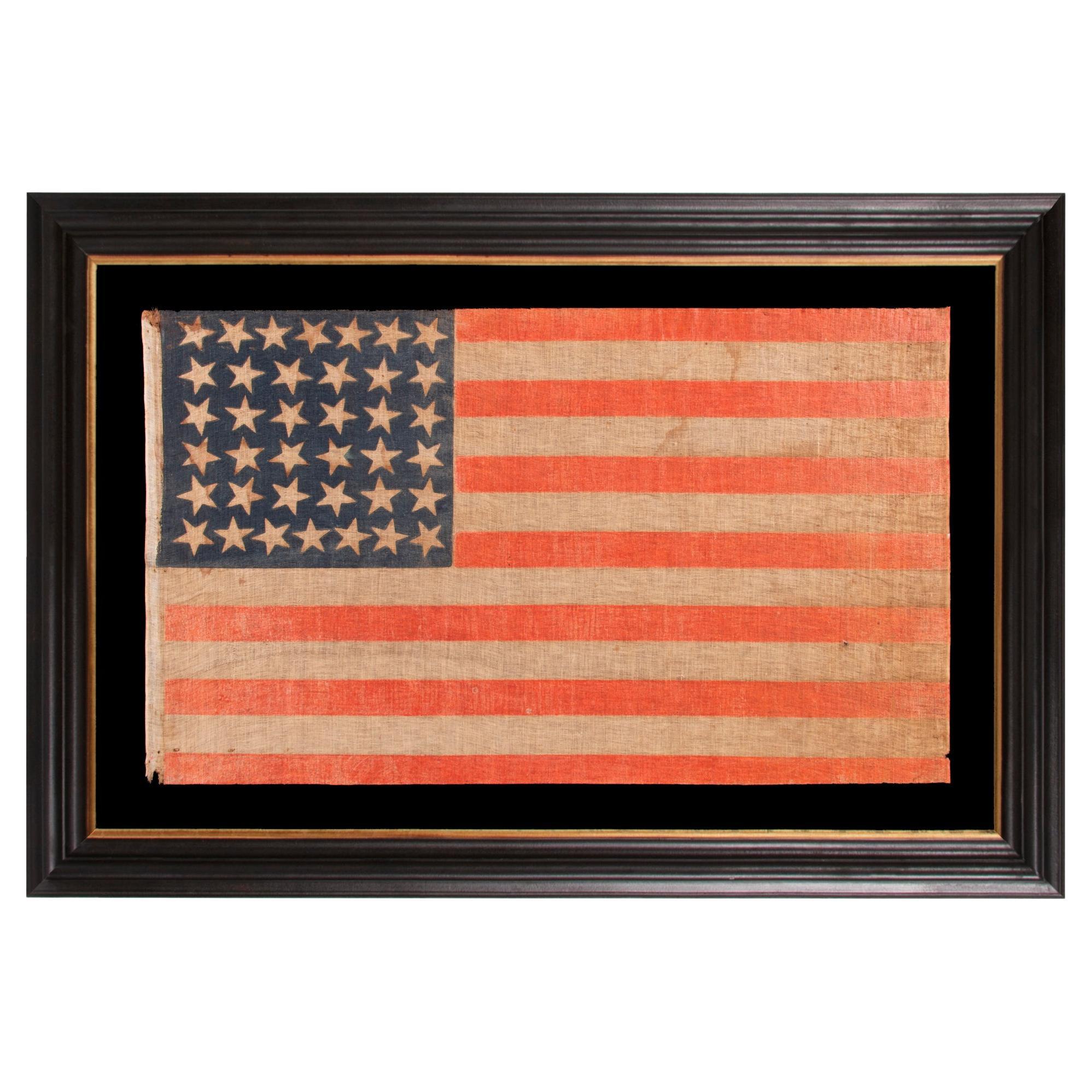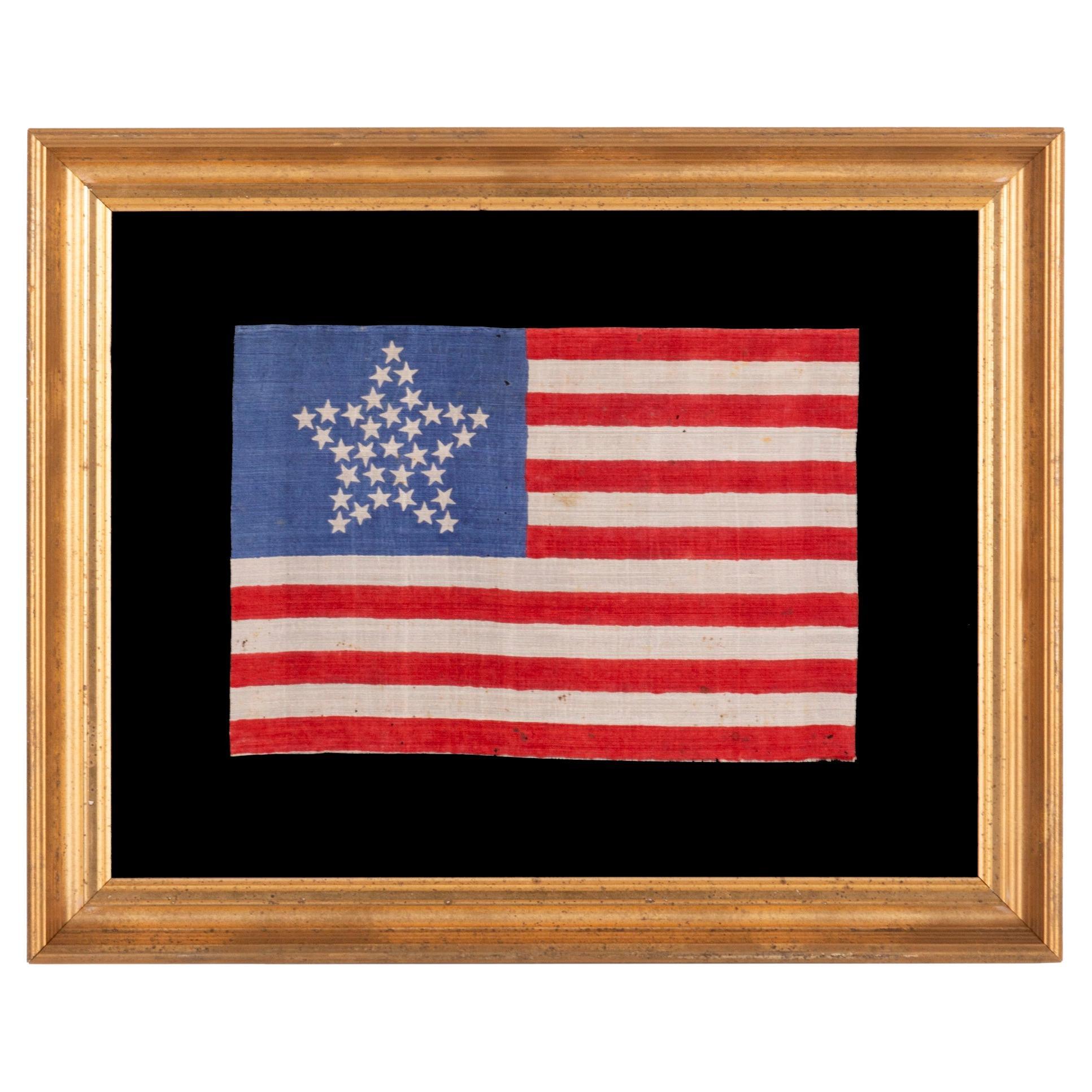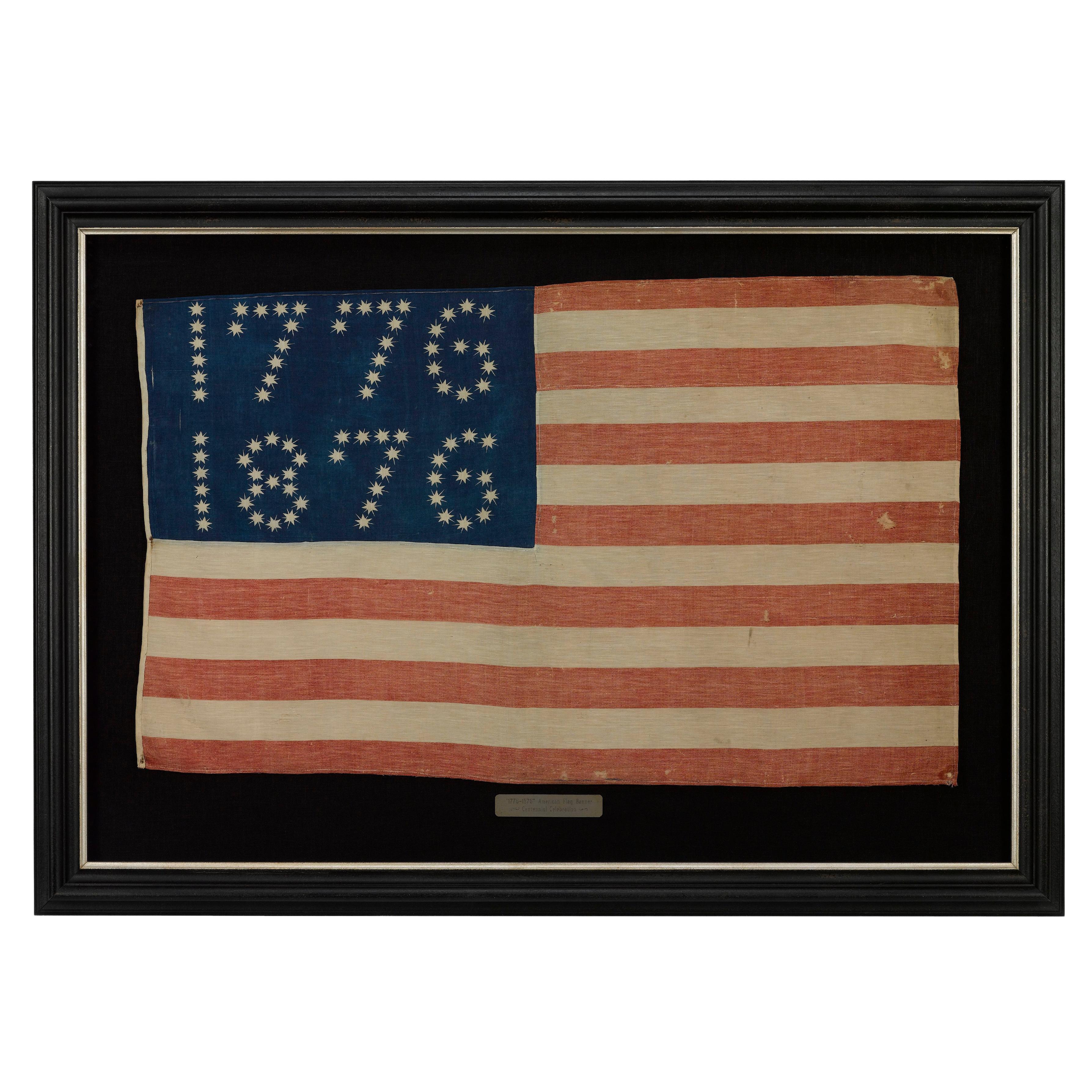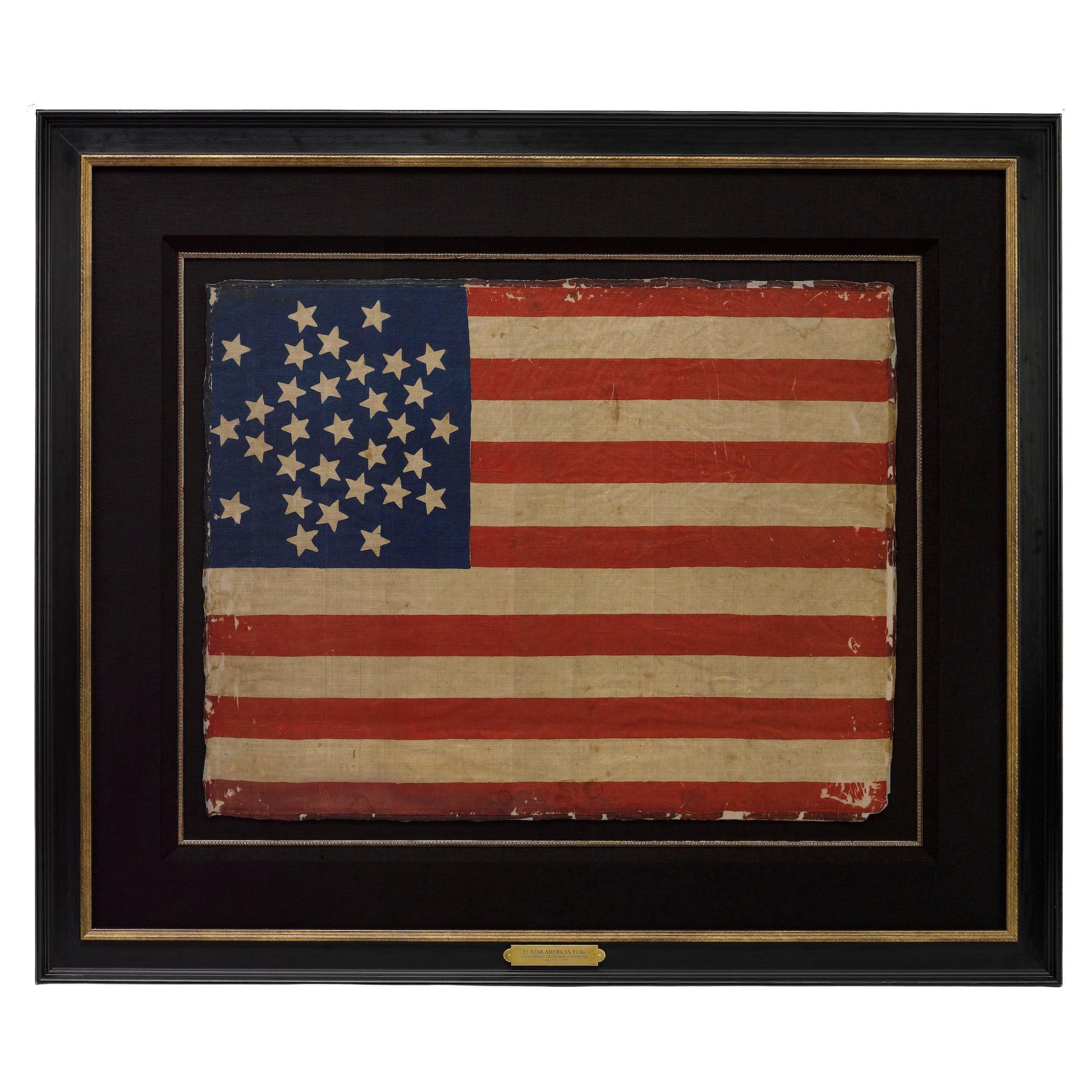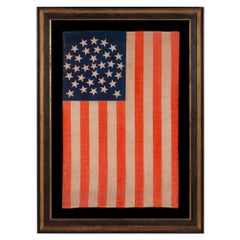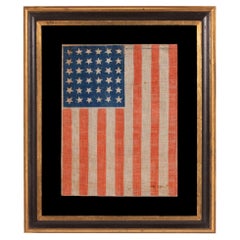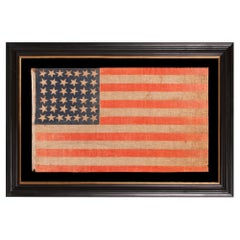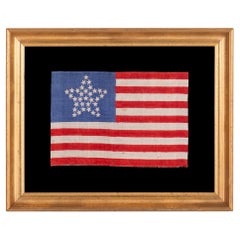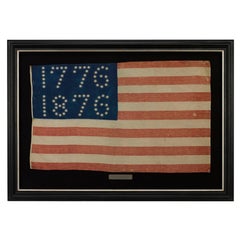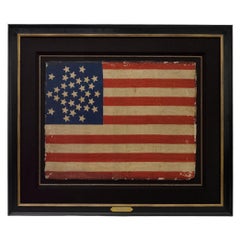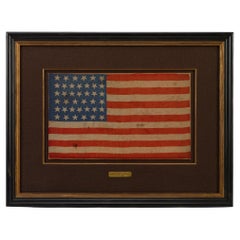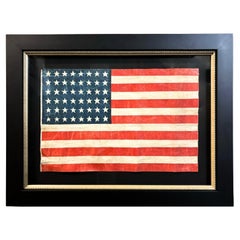Items Similar to Hand-Painted Patriotic Banner with the Seal of the State of Oregon
Want more images or videos?
Request additional images or videos from the seller
1 of 7
Hand-Painted Patriotic Banner with the Seal of the State of Oregon
Price Upon Request
Price Upon Request
Price Upon Request
Price Upon Request
Price Upon Request
Price Upon Request
Price Upon Request
Price Upon Request
Price Upon Request
Price Upon Request
Shipping
Retrieving quote...The 1stDibs Promise:
Authenticity Guarantee,
Money-Back Guarantee,
24-Hour Cancellation
About the Item
HAND-PAINTED PATRIOTIC BANNER WITH THE SEAL OF THE STATE OF OREGON AND GREAT FOLK QUALITIES, 1861-1876:
Swallowtail format, patriotic vertical banner bearing the name and the seal of the State of Oregon. Made in the period between 1861 and the 1876 centennial of American independence, the textile is entirely hand-painted on heavy cotton or linen.
Note the bold and interesting imagery, which includes a modernistic, folded streamer on a cornflower blue register with 22 visible stars. In the centre of the red and white striped field below, which ends in a forked swallowtail, is a rendition of a seal used by the Oregon Territory.
The seal of the State of Oregon was actually designed in 1857, two years before Oregon became a state, with the expressed intent that it would be adopted when statehood was achieved. The first seal of the Oregon Territory was employed by its provisional government, between 1843 and 1849. It featured a salmon fish below three sheaves of wheat. When the territorial government arrived in 1849, the "Salmon Seal" was replaced by a new device, which is very similar to the one featured on this banner. Artists painting state seals in early America often exercised great liberty in their work, but this example is surprisingly true to form. It features a beaver above a fanciful, scrollwork shield, flanked by a Native American on the left and an eagle in the lower right. Charges in the escutcheon include a tall ship at the top canton and a landscape with mountains below. Deviations include the lack of five, five-pointed stars arched below and the placement of the latin motto "Alis Volat Propriis" (she flies with her own wings). On the actual seal, the motto appears in a circular arch along the top. One the banner, it is placed below within a billowing red streamer.
This textile was found among a series of banners representing Mississippi, Delaware, Pennsylvania, Virginia, Illinois, Louisiana, and New York City. One representing Kansas is also known. Kansas joined the Union in 1861. Unless like banners were produced for some of the Western Territories, in anticipation of future statehood, the group dates no earlier than that year. The presence of the New York City example suggests that whatever event they were used at occurred in New York.
Based Upon the minor to significant deviations from "official" designs that are present among the other banners, it seems likely that whomever was painting the devices was probably working from a series of drawings or perhaps, in some cases, even written descriptions. There would have been no widely available book or chart that would contain every state seal and even if there was, it would not have been kept up-to-date with yearly revisions. Nineteenth century flag-makers would have had to make do with whatever information was available to them.
Banners of this type were often hoisted on single vertical staffs that held the rope aloft in the center. This basic style was both carried in parades and affixed on mounts indoors. Similar decorations and banners can be seen along the walls at early political conventions, or hoisted among benches, where they denoted the positions of the seating of attendees from various states. The 1868 Democrat National Convention was held in Manhattan at Tammany Hall. A colorful illustration, printed for Joseph Shannon’s Manual of the Corporation of the City of New York, shows the interior of the building masterfully festooned with patriotic banners, medallions, and buntings of similar nature, but none that match this particular style. Only the front and central interior are pictured, but two full sets of state identifying decorations are shown. This banner and its mates could well have hung elsewhere on the premises. No Republican National Conventions were held in New York during the 19th century.
An alternative possibility is that the banners were used in festivities pertaining to the centennial of American independence in 1876, either in New York or at an event such as the Centennial International Exhibition in Philadelphia, a six-month long World's Fair event, where a city like New York probably had its own pavilion, along with each individual state.
Whatever the case may be, the textile is a boldly graphic, colorful survivor and presently represents the only 19th century textile of its kind that displays this device of the Oregon Territory. Note the interesting folk features in the face of the Indian and the stylized eagle, which is unique to the artist who painted all of the banners in the series. Note also the metallic painted, scrollwork window in which the shield is displayed.
Construction: Painted cotton or linen tacked to a wooden staff with acorn finials that is original to the banner. A length of red wool tape was used to reinforce the point where the tacks are affixed.
Mounting: The banner has been hand-stitched to a background 100% cotton, black in color, which was washed to reduce excess dye. An acid-free agent was added to the wash to further set the dye, which was heat-treated for the same purpose. The mount was then placed in a black-painted, hand-gilded and distressed Italian molding. A shadowbox was created to accommodate the staff. The glazing is U.V. protective acrylic.
Condition: There is minor soiling and there was minor to moderate paint loss, especially towards the bottom of the stripe field. Professional restoration was undertaken, particularly to strengthen the presentation in this area, but great care was taken to tread lightly and preserve the original condition.
Measures: Frame size (H x L): 78.75" x 50.25"
Flag size (H x L): 65" x 34".
- Dimensions:Height: 78.75 in (200.03 cm)Width: 50.25 in (127.64 cm)Depth: 4 in (10.16 cm)
- Materials and Techniques:
- Place of Origin:
- Period:
- Date of Manufacture:1861-1876
- Condition:See Item Description.
- Seller Location:York County, PA
- Reference Number:Seller: pat-2451stDibs: LU84976827243
About the Seller
5.0
Recognized Seller
These prestigious sellers are industry leaders and represent the highest echelon for item quality and design.
Established in 1991
1stDibs seller since 2008
70 sales on 1stDibs
Typical response time: 1 to 2 days
- ShippingRetrieving quote...Shipping from: York County, PA
- Return Policy
Authenticity Guarantee
In the unlikely event there’s an issue with an item’s authenticity, contact us within 1 year for a full refund. DetailsMoney-Back Guarantee
If your item is not as described, is damaged in transit, or does not arrive, contact us within 7 days for a full refund. Details24-Hour Cancellation
You have a 24-hour grace period in which to reconsider your purchase, with no questions asked.Vetted Professional Sellers
Our world-class sellers must adhere to strict standards for service and quality, maintaining the integrity of our listings.Price-Match Guarantee
If you find that a seller listed the same item for a lower price elsewhere, we’ll match it.Trusted Global Delivery
Our best-in-class carrier network provides specialized shipping options worldwide, including custom delivery.More From This Seller
View All33 Star Antique American Parade Flag, Oregon Statehood, ca 1859-1861
Located in York County, PA
33 STARS IN A MEDALLION CONFIGURATION ON A LARGE SCALE ANTIQUE AMERICAN PARADE FLAG, AN EXTREMELY RARE EXAMPLE, OREGON STATEHOOD, 1859-1861
This 33 star American parade flag, printe...
Category
Antique Mid-19th Century American Political and Patriotic Memorabilia
Materials
Cotton
36 Star Antique Parade Flag, Vertical Position, Nevada Statehood, ca 1861-1867
Located in York County, PA
36 STAR ANTIQUE AMERICAN PARADE FLAG, WITH STARS THAT ALTERNATE IN THEIR VERTICAL POSITION FROM COLUMN TO COLUMN AND ROW-TO-ROW, PRINTED ON AN ESPECIALLY INTERESTING LENGTH OF COARSE...
Category
Antique Late 19th Century American Political and Patriotic Memorabilia
Materials
Cotton
38 Star Antique American Parade Flag, Colorado Statehood, ca 1876-1889
Located in York County, PA
38 STAR ANTIQUE AMERICAN PARADE FLAG WITH JUSTIFIED ROWS OF 7-6-6-6-6-7 AND SCATTERED STAR ORIENTATION, MADE DURING THE PERIOD WHEN COLORADO WAS THE MOST RECENT STATE TO JOIN THE UNION, 1876-1889
38 star American national parade flag, printed on coarse cotton, possibly with flax content. One of the flag’s most interesting features is the wild sweep of the grain of the fabric, the warp and weft of which are anything but perpendicular.
The stars are arranged in justified rows of 7-6-6-6-6-7. This results in a secondary pattern that I commonly call a “box-in-a-box-in-a-box”, because of the way in which the seemingly haphazard arrangement creates three consecutive squares. Note how the stars point in various directions on their vertical axis, which adds a nice element of folk quality to the overall design.
Most parade flags in this star count have red stripes that lean heavily toward orange, with a vibrant, chromatic luster. This was common across printed flags produced between the 1850's and the 38 star period, phasing out in the last decade of the 19th century. Also note how the wear and patina contribute to an endearing presentation that displays its long-term use gracefully.
Colorado became the 38th state on August 1st, 1876. This was the year of our nation’s 100-year anniversary of independence. Per the Third Flag Act of 1818, stars were not officially added until the 4th of July following a state's addition. For this reason, 37 was the official star count for the American flag in 1876. In the latter 19th century, it became common to add stars before the respective state(s) had even entered the Union. No one cared what was official, not even the military, where the matter of practicality with regard to flags always seems to have outweighed regulations. In the private sector, commercial flag-making was a competitive venture. Few flag-makers continued to produce 37 star flags when their competitors had jumped the star count to 38. It is for this reason that 38 and 13 stars (to represent the original 13 colonies) are more often seen at the Centennial International Exposition, the six-month long World’s Fair, held in Philadelphia, that served as the nucleus of the national celebration.
Some makers of printed parade flags actually began to produce 39 star flags in 1876, in hopeful anticipation of the addition of two more Western Territories instead of one. The 39th state would not join the Union for another 13 years, however, when the Dakota Territory—thought to be coming as a single state—entered as two separate states on November 2nd, 1889. The 38 star flag generally fell out of production at that time, though it technically remained official until July 3rd, 1890.
President Ulysses S. Grant was in office when the first 38 star flags would have appeared. The list of presidents that served during the period when the 38 star flag was official include Rutherford B. Hayes, James Garfield...
Category
Antique Late 19th Century American Political and Patriotic Memorabilia
Materials
Cotton
Price Upon Request
33 Star Flag with Stars in a "Great Star" Pattern, Oregon State, ca 1859-1861
Located in York County, PA
33 STARS IN A "GREAT STAR" PATTER ON A BRILLIANT, ROYAL BLUE CANTON, A RARE AND EXTRAORDINARY EXAMPLE, PRE-CIVIL WAR THROUGH THE WAR'S OPENING YEAR, 1859-1861, OREGON STATEHOOD
33 s...
Category
Antique Mid-19th Century American Political and Patriotic Memorabilia
Materials
Silk
Hand-Painted Patriotic Banner With The Seal of the State of Illinois
Located in York County, PA
HAND-PAINTED PATRIOTIC BANNER WITH THE SEAL OF THE STATE OF ILLINOIS AND GREAT FOLK QUALITIES PROBABLY MADE FOR THE 1868 DEMOCRAT NATIONAL CONVENTION...
Category
Antique 1860s North American Political and Patriotic Memorabilia
Materials
Canvas
Price Upon Request
44 Star Antique American Parade Flag, Wyoming Statehood, ca 1890-1896
Located in York County, PA
44 STAR ANTIQUE AMERICAN PARADE FLAG WITH ENDEARING WEAR FROM LONG TERM USE AND WITH ITS STARS ARRANGED IN A NOTCHED PATTERN THAT LEAVES 4 SPACES OPEN FOR THE REMAINING WESTERN TERRI...
Category
Antique 1890s American Political and Patriotic Memorabilia
Materials
Cotton
Price Upon Request
You May Also Like
Centennial Celebration "1776-1876" American Flag Banner
Located in Colorado Springs, CO
Presented is a rare Centennial patriotic flag banner, dating to 1876. The flag’s brilliant blue canton is spectacular, with 81 five-pointed, rayed stars, arranged to read “1776” and “1876.” The flag’s design is completed with thirteen alternating red and white stripes. The flag is a three-piece, treadle-sewn sewn construction, printed on a thin wool and cotton blend. Along the edge, there is a narrow, treadle-sewn sleeve made of cotton tape.
In the lead up to the nation’s Centennial in 1876, flag makers and individuals looked to the past for designs to produce as part of the country’s many celebrations. Popular interpretation of the stars and stripes undoubtedly reached its climax of variety and originality at the time of our Nation’s first Centennial. Since no design restrictions were placed on flagmaker’s imaginations and no strict distinctions were drawn between official and unofficial star counts, it is no surprise that, on the occasion of the Centennial, creativity in flag design was not the exception, but the rule.
The cantons from this period presented an array of geometric abstractions. Great star patterns, referred to as the “starry flower of Liberty” by Oliver Wendell Holmes, that were popular from 1818 and on, resurfaced in Centennial flags...
Category
Antique 1870s American Political and Patriotic Memorabilia
Materials
Wool, Cotton
31-Star Printed American Flag, Celebrating California Statehood, Circa 1850
Located in Colorado Springs, CO
This is a rare 31-star medallion printed American flag, celebrating the addition of California to the Union. The flag is printed on silk and has a spectacular “Great Star” canton pat...
Category
Antique 1850s American Political and Patriotic Memorabilia
Materials
Silk
39-Star Printed American Flag, Commemorating North Dakota Statehood, 1889-1890
Located in Colorado Springs, CO
This is a 39-star unofficial American flag, celebrating North Dakota statehood. The printed flag dates to 1889 and showcases a “whimsical” star pattern in the canton. The flag's cant...
Category
Antique 1880s American Political and Patriotic Memorabilia
Materials
Fabric
48-Star Printed American Flag, Commemorating Arizona Statehood, 1912-1958
Located in Colorado Springs, CO
This is an original 48-star American parade flag, celebrating Arizona statehood. A wonderful product of our nation's early history, this flag is an authentic antique, with a fly date...
Category
Mid-20th Century American Political and Patriotic Memorabilia
Materials
Fabric
38-Star American Parade Flag, Flown at a Reception for President Grant, 1880
Located in Colorado Springs, CO
This is a beautifully colored 38-star American parade flag, flown at a public reception for Ulysses S. Grant in October of 1880. This printed flag features a rare, triple medallion s...
Category
Antique 1880s American Political and Patriotic Memorabilia
Materials
Cotton
Vintage 1912 Arizona and New Mexico Statehood Flag
Located in Coeur d'Alene, ID
25th Design Patriotic American silk flag with 48 stars. Arizona Statehood Feb 14, 1912; New Mexico Statehood Jan 6, 1912
Period: 1912
Origin: United States
Size: 12" x 17".
Family ...
Category
Vintage 1910s American Historical Memorabilia
Materials
Silk
More Ways To Browse
Hand Painted Antique Windows
Folk Art Fish
The Beaver
Wooden Painted Fish
Hand Painted Banner
Centennial 1876
Great Seal Of The United States
Antique Oregon
Staff Wooden Staff
Antique Flies
Western Memorabilia
Antique Red Bench
Antique Blue Benches
Antique Measuring Tapes
Antique Tape Measure
Early American Bench
Eagle Shield
Wool Flag
